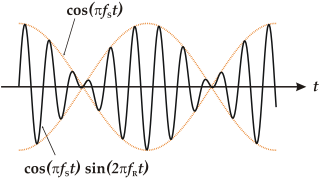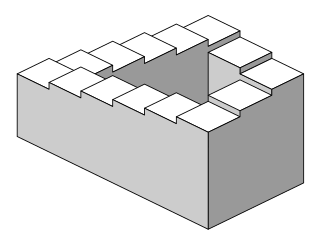
A Shepard tone, named after Roger Shepard, is a sound consisting of a superposition of sine waves separated by octaves. When played with the bass pitch of the tone moving upward or downward, it is referred to as the Shepard scale. This creates the auditory illusion of a tone that seems to continually ascend or descend in pitch, yet which ultimately gets no higher or lower.

Pitch is a perceptual property of sounds that allows their ordering on a frequency-related scale, or more commonly, pitch is the quality that makes it possible to judge sounds as "higher" and "lower" in the sense associated with musical melodies. Pitch is a major auditory attribute of musical tones, along with duration, loudness, and timbre.
Auditory illusions are false perceptions of a real sound or outside stimulus. These false perceptions are the equivalent of an optical illusion: the listener hears either sounds which are not present in the stimulus, or sounds that should not be possible given the circumstance on how they were created.

A harmonic sound is said to have a missing fundamental, suppressed fundamental, or phantom fundamental when its overtones suggest a fundamental frequency but the sound lacks a component at the fundamental frequency itself. The brain perceives the pitch of a tone not only by its fundamental frequency, but also by the periodicity implied by the relationship between the higher harmonics; we may perceive the same pitch even if the fundamental frequency is missing from a tone.
The glissando illusion is an auditory illusion, created when a sound with a fixed pitch, such as a synthesized oboe tone, is played together with a sine wave gliding up and down in pitch, and they are both switched back and forth between stereo loudspeakers. The effect is that the oboe is heard as switching between loudspeakers while the sine wave is heard as joined together seamlessly, and as moving around in space in accordance with its pitch motion. Right-handers often hear the glissando as traveling from left to right as its pitch glides from low to high, and then back from right to left as its pitch glides from high to low.

The tritone paradox is an auditory illusion in which a sequentially played pair of Shepard tones separated by an interval of a tritone, or half octave, is heard as ascending by some people and as descending by others. Different populations tend to favor one of a limited set of different spots around the chromatic circle as central to the set of "higher" tones. Roger Shepard in 1963 had argued that such tone pairs would be heard ambiguously as either ascending or descending. However, psychology of music researcher Diana Deutsch in 1986 discovered that when the judgments of individual listeners were considered separately, their judgments depended on the positions of the tones along the chromatic circle. For example, one listener would hear the tone pair C–F♯ as ascending and the tone pair G–C♯ as descending. Yet another listener would hear the tone pair C–F♯ as descending and the tone pair G–C♯ as ascending. Furthermore, the way these tone pairs were perceived varied depending on the listener's language or dialect.
Deutsch's scale illusion is an auditory illusion in which two series of unconnected notes appear to combine into a single recognisable melody, when played simultaneously into the left and right ears of a listener.
Diana Deutsch is a British-American psychologist from London, England. She's a professor of psychology at the University of California, San Diego, and is a prominent researcher on the psychology of music. Deutsch is primarily known for her discoveries in music and speech illusions. She also studies the cognitive foundation of musical grammars, which consists of the way people hold musical pitches in memory, and how people relate the sounds of music and speech to each other. In addition, she is known for her work on absolute pitch, which she has shown is far more prevalent among speakers of tonal languages. Deutsch is the author of Musical Illusions and Phantom Words: How Music and Speech Unlock Mysteries of the Brain (2019), the editor for Psychology of Music, and also the compact discs Musical Illusions and Paradoxes (1995) and Phantom Words and Other Curiosities (2003).

In acoustics, a beat is an interference pattern between two sounds of slightly different frequencies, perceived as a periodic variation in volume whose rate is the difference of the two frequencies.

Volley theory states that groups of neurons of the auditory system respond to a sound by firing action potentials slightly out of phase with one another so that when combined, a greater frequency of sound can be encoded and sent to the brain to be analyzed. The theory was proposed by Ernest Wever and Charles Bray in 1930 as a supplement to the frequency theory of hearing. It was later discovered that this only occurs in response to sounds that are about 500 Hz to 5000 Hz.
In music, tonal memory or "aural recall" is the ability to remember a specific tone after it has been heard. Tonal memory assists with staying in tune and may be developed through ear training. Extensive tonal memory may be recognized as an indication of potential compositional ability.
Dichotic pitch is a pitch heard due to binaural processing, when the brain combines two noises presented simultaneously to the ears. In other words, it cannot be heard when the sound stimulus is presented monaurally but, when it is presented binaurally a sensation of a pitch can be heard. The binaural stimulus is presented to both ears through headphones simultaneously, and is the same in several respects except for a narrow frequency band that is manipulated. The most common variation is the Huggins Pitch, which presents white-noise that only differ in the interaural phase relation over a narrow range of frequencies. For humans, this phenomenon is restricted to fundamental frequencies lower than 330 Hz and extremely low sound pressure levels. Experts investigate the effects of the dichotic pitch on the brain. For instance, there are studies that suggested it evokes activation at the lateral end of Heschl's gyrus.
Diplacusis, also known as diplacusis binauralis, binauralis disharmonica or interaural pitch difference (IPD), is a hearing disorder whereby a single auditory stimulus is perceived as different pitches between ears. It is typically experienced as a secondary symptom of sensorineural hearing loss, although not all patients with sensorineural hearing loss experience diplacusis or tinnitus. The onset is usually spontaneous and can occur following an acoustic trauma, for example an explosive noise, or in the presence of an ear infection. Sufferers may experience the effect permanently, or it may resolve on its own. Diplacusis can be particularly disruptive to individuals working within fields requiring acute audition, such as musicians, sound engineers or performing artists.

Illusory conjunctions are psychological effects in which participants combine features of two objects into one object. There are visual illusory conjunctions, auditory illusory conjunctions, and illusory conjunctions produced by combinations of visual and tactile stimuli. Visual illusory conjunctions are thought to occur due to a lack of visual spatial attention, which depends on fixation and the amount of time allotted to focus on an object. With a short span of time to interpret an object, blending of different aspects within a region of the visual field – like shapes and colors – can occasionally be skewed, which results in visual illusory conjunctions. For example, in a study designed by Anne Treisman and Schmidt, participants were required to view a visual presentation of numbers and shapes in different colors. Some shapes were larger than others but all shapes and numbers were evenly spaced and shown for just 200 ms. When the participants were asked to recall the shapes they reported answers such as a small green triangle instead of a small green circle. If the space between the objects is smaller, illusory conjunctions occur more often.
The neuroscience of music is the scientific study of brain-based mechanisms involved in the cognitive processes underlying music. These behaviours include music listening, performing, composing, reading, writing, and ancillary activities. It also is increasingly concerned with the brain basis for musical aesthetics and musical emotion. Scientists working in this field may have training in cognitive neuroscience, neurology, neuroanatomy, psychology, music theory, computer science, and other relevant fields.
Psychoacoustics is the branch of psychophysics involving the scientific study of sound perception and audiology—how human auditory system perceives various sounds. More specifically, it is the branch of science studying the psychological responses associated with sound. Psychoacoustics is an interdisciplinary field of many areas, including psychology, acoustics, electronic engineering, physics, biology, physiology, and computer science.

Pitch circularity is a fixed series of tones that are perceived to ascend or descend endlessly in pitch. It's an example of an auditory illusion.
In music cognition, melodic fission, is a phenomenon in which one line of pitches is heard as two or more separate melodic lines. This occurs when a phrase contains groups of pitches at two or more distinct registers or with two or more distinct timbres.
Stimulus–response (S–R) compatibility is the degree to which a person's perception of the world is compatible with the required action. S–R compatibility has been described as the "naturalness" of the association between a stimulus and its response, such as a left-oriented stimulus requiring a response from the left side of the body. A high level of S–R compatibility is typically associated with a shorter reaction time, whereas a low level of S-R compatibility tends to result in a longer reaction time, a phenomenon known as the Simon effect.
Temporal envelope (ENV) and temporal fine structure (TFS) are changes in the amplitude and frequency of sound perceived by humans over time. These temporal changes are responsible for several aspects of auditory perception, including loudness, pitch and timbre perception and spatial hearing.









